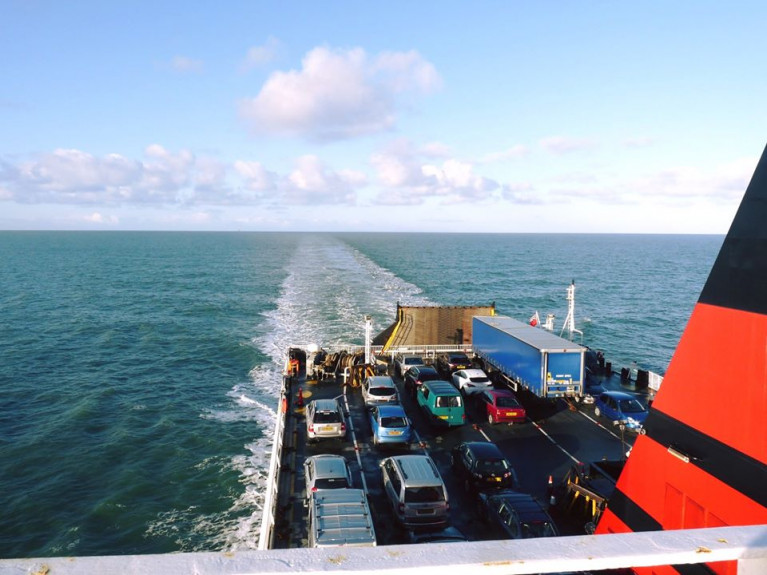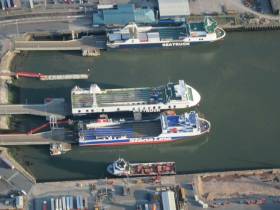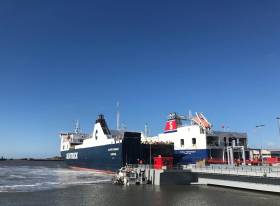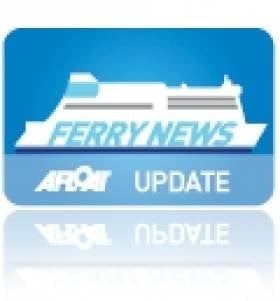Displaying items by tag: Heysham Port
Ongoing Silting at Heysham Port Continues to Affect Isle of Man Sailings
At the Irish Sea ferry port of Heysham, ongoing silt issues are continuing to affect the Isle of Man Steam Packet Company sailings.
Both tonight's crossings will depart earlier, according to Manx Radio
Tonight's (29th December) 7.45pm crossing will now be departing an hour earlier at 6.45pm with passengers asked to check in no later than 6.15pm.
The overnight crossing due to leave at 2.15am tomorrow morning will now be leaving at 11.45pm tonight, with the final check in at 11.15pm.
The 2.15pm sailing this afternoon is not affected.
See related report on Fleetwood, a former ferryport also located in north-west England.
Irish Sea Port Wins Project of the Year Award
#ferry -The Irish Sea port of Heysham on the UK west coast has won the Project of the Year Award.
The Award which was announced at the Peel Ports Group annual conference, reflected the work managed by the port teams across the UK network over the past year.
Costing £10m was the Heysham Capital Projects, which as the winner was recognised as a stand-out project at the conference awards. Mark Patterson accepted the award after being nominated by Stephen Mackenzie, head of projects for Peel Ports Group.
Three parts were involved in the project at Heysham Harbour that saw both new and upgraded facilities installed at the Lancashire port. The primary project was to install a new linkspan as Afloat previously reported for ports customers that serve Belfast, Douglas, Dublin and Warrenpoint
The infrastructure is to provide an improved service to existing customers, as well as bringing new capabilities for growing business at the port.
#FerryNews- Heysham Port on the Irish Sea, is where a new link-span bridge was officially unveiled, as part of £10m investment by the port owner-operator Peel Ports to increase throughput at the Lancashire port in north-west England.
The investment according to Peel Ports is a direct response to the economic potential facilitated by the Bay Gateway link road that connects Heysham directly with the M6.
The port is already a key gateway for Irish Sea trade with numerous daily sailings operated by Seatruck, Stena Line and the Isle of Man Steam Packet Company.
As well as the new link-span, which provides a third berth for freight and passenger traffic, the investment also includes a new port entrance and a pontoon for offshore crew transfer vessels, which is currently under construction and is set to open later this year.
A new terminal operating system supplied by Hogia has also been introduced to digitise the management of freight transport through the terminal, helping to improve operational efficiency.
The investments by Peel Ports have been made within 18 months of the opening of the new £140m link road which bypasses congestion in Lancaster. The 4.8km route cuts the journey time for goods traded between the UK and Ireland by 30 minutes, offering a significant cost saving to cargo owners and hauliers.
According to some studies before the road opened, the economic growth forecast could potentially support 250 new jobs in port-related activity and hundreds more in haulage, logistics and distribution. It is estimated that for £1 invested, the link road will earn £4.40 for the local economy.
Heysham Port's New £10m Ro-Ro Ramp Linkspan Berth Installed for Growing Irish Sea Freight
#FerryNews - Heysham Port in recent weeks has had a new ro-ro ramp linkspan installed bringing to three berthing facilities serving the growing Irish Sea trade through the Lancashire port, writes Jehan Ashmore.
The £10m investment by the Peel Ports operated harbour has created a dedicated loading berth and allows a much greater schedule reliability for chief customer Seatruck Ferries and Stena Line.
The ramp linkspan constructed in the Netherlands was towed to the port. At close to 100m long, the ramp is designed to deal with the large 10m rise and fall in tide that is experienced at Heysham.
Seatruck has routes to Warrenpoint, Co. Down and Dublin Port. A twice daily service is operated to Warrenpoint and single sailing to the Irish capital. Together three freight-ferries operate these routes. They are Seatruck Panorama, Clipper Pennant and Seatruck Pace which alone serves the Dublin route.
Rivals, Stena Line operate to Belfast Port, using chartered tonnage from Seatruck. The ro-ro freight ferry on this second of the Heysham-Northern Ireland routes is served by Stena Performer.
According to Seatruck, the funding in Heysham Port, will also see a new pontoon built to support offshore crew transfer vessels. In addition the construction of a new port entrance and various improvements to the port IT and terminal operating systems.
A third port user, Isle of Man Steam Packet operate a passenger and freight service to Douglas. This year-round route is the main service link between the UK and the island.
Dredging Continues on Approach Channel to Heysham
#DredgingHeysham – The Port of Heysham have assured the Isle of Man Steam Packet Company that tidal and silting issues at the Irish Sea port which has led to several sailings being rescheduled this week, will soon be resolved.
The Lancashire port owned by Peel Ports Group is responsible for maintaining approach channels for all customers (among them Seatruck Ferries), has conducted several weeks of dredging. This has involved the hopper-dredger Albatross to restore the minimum low tide water depth required to access berths.
The port which handles around 30,000 shipping movements annually along its approaches have historically suffered from silting issues. This has required periodic dredging to maintain the minimum depths of water required at low tide for the safe passage of vessels.
Regular soundings are also carried out by the port's owners to check water depths.
Winter storms can sometimes exacerbate the issue as sandbanks shift and local weather conditions can occasionally affect the actual level of low tides compared with predictions.
During the past week, some very low tides coupled with a build-up of silt have led to some Ben-my-Chree services between Douglas and Heysham being rescheduled.
Steam Packet Company Chief Executive Mark Woodward said: 'During most of the year Ben-my-Chree and other vessels can use their standard berth "slots" but, at certain low tide periods, there needs to be a minor timing variation if the water depth is insufficient. Each year the Steam Packet Company and other port customers liaise with Heysham Port on timetables to ensure that changes to "standard" schedules are minimal and pre-planned.
'However, this past winter the port has not been able to maintain the minimum depth of water originally planned and, despite dredging of the approaches and port having been under way for some weeks and soundings constantly being updated, this has resulted in some late schedule changes to accommodate the current situation.'
He added: 'Peel Ports has assured the Company that its dredging will all be completed prior to the busy TT period.'




























































